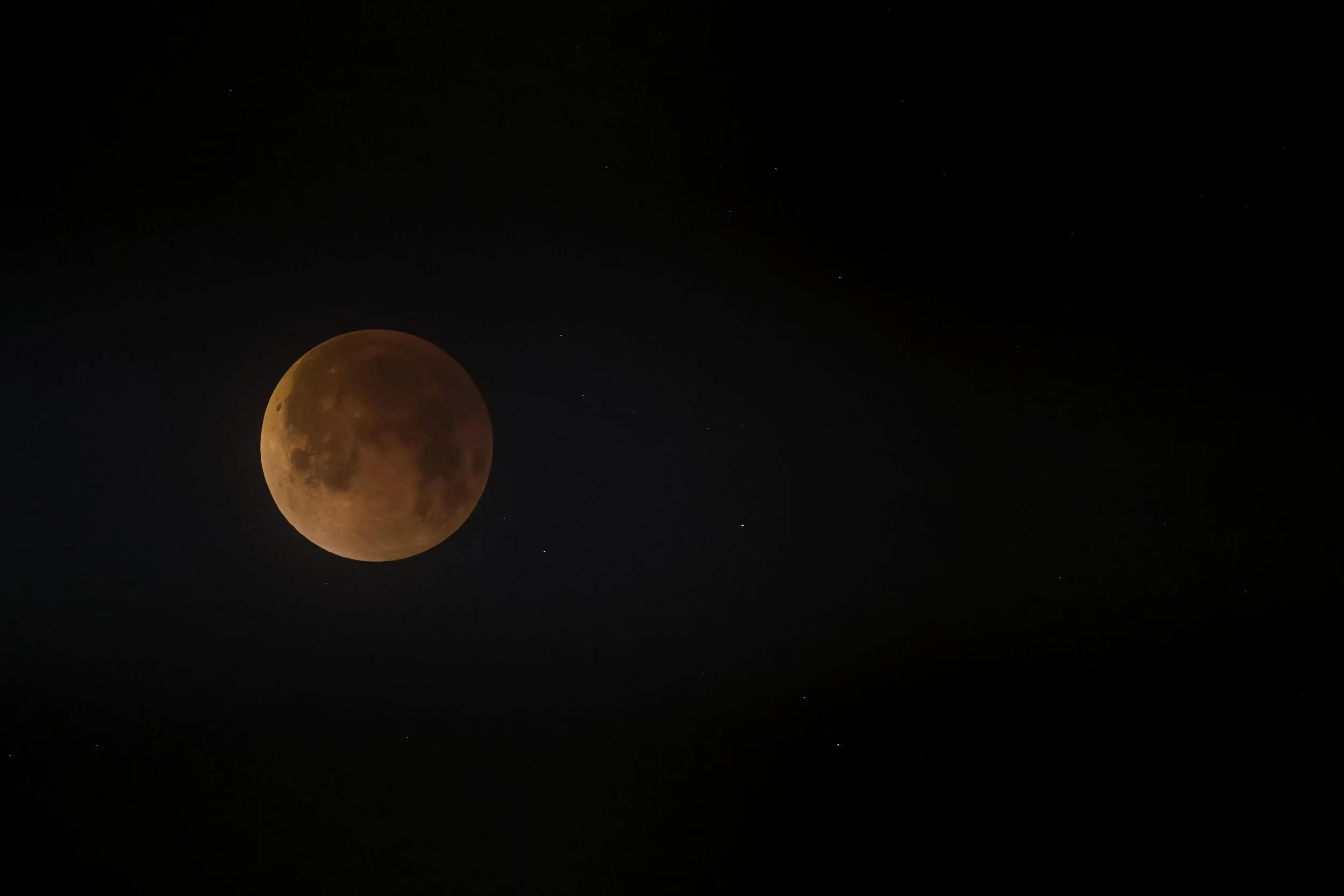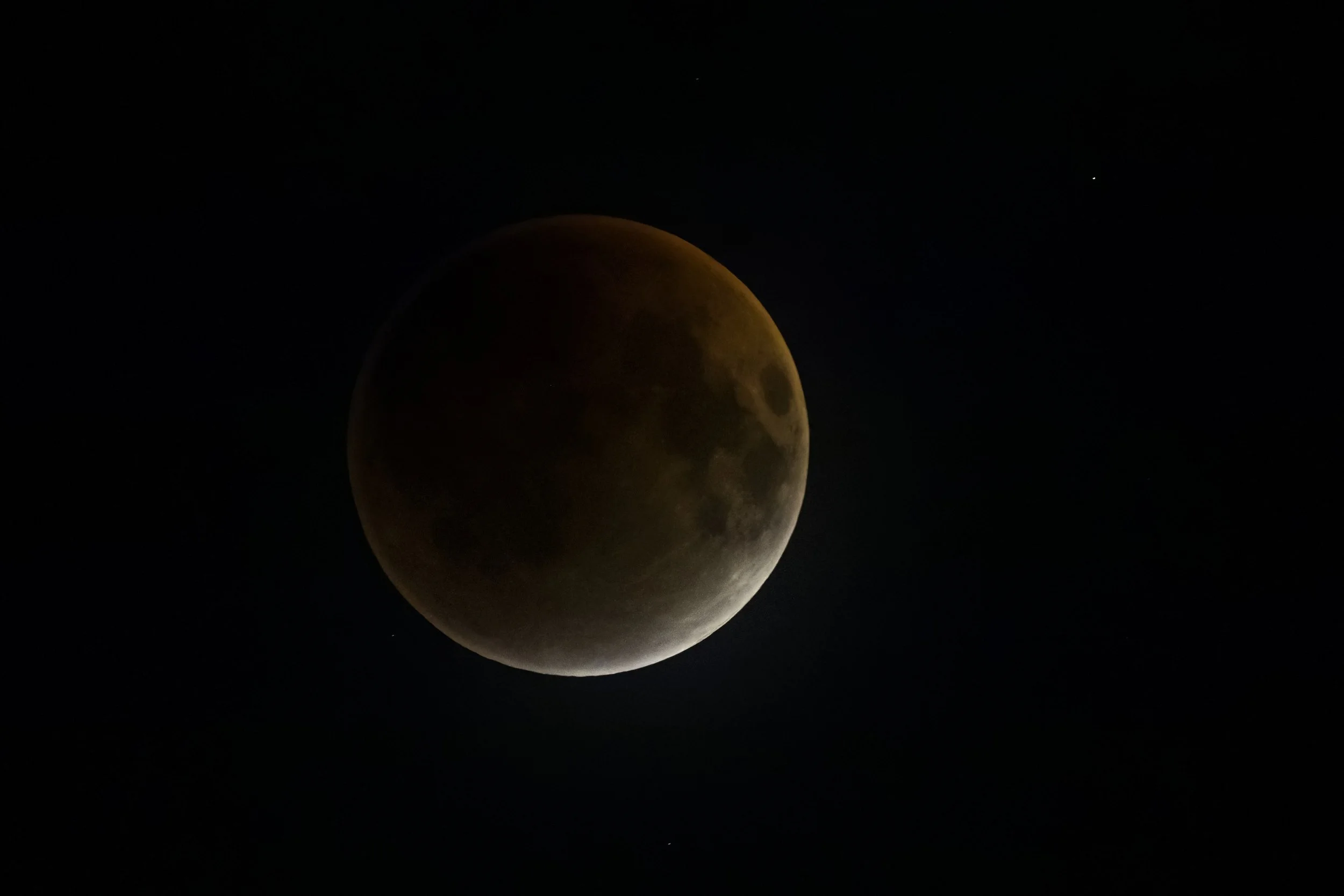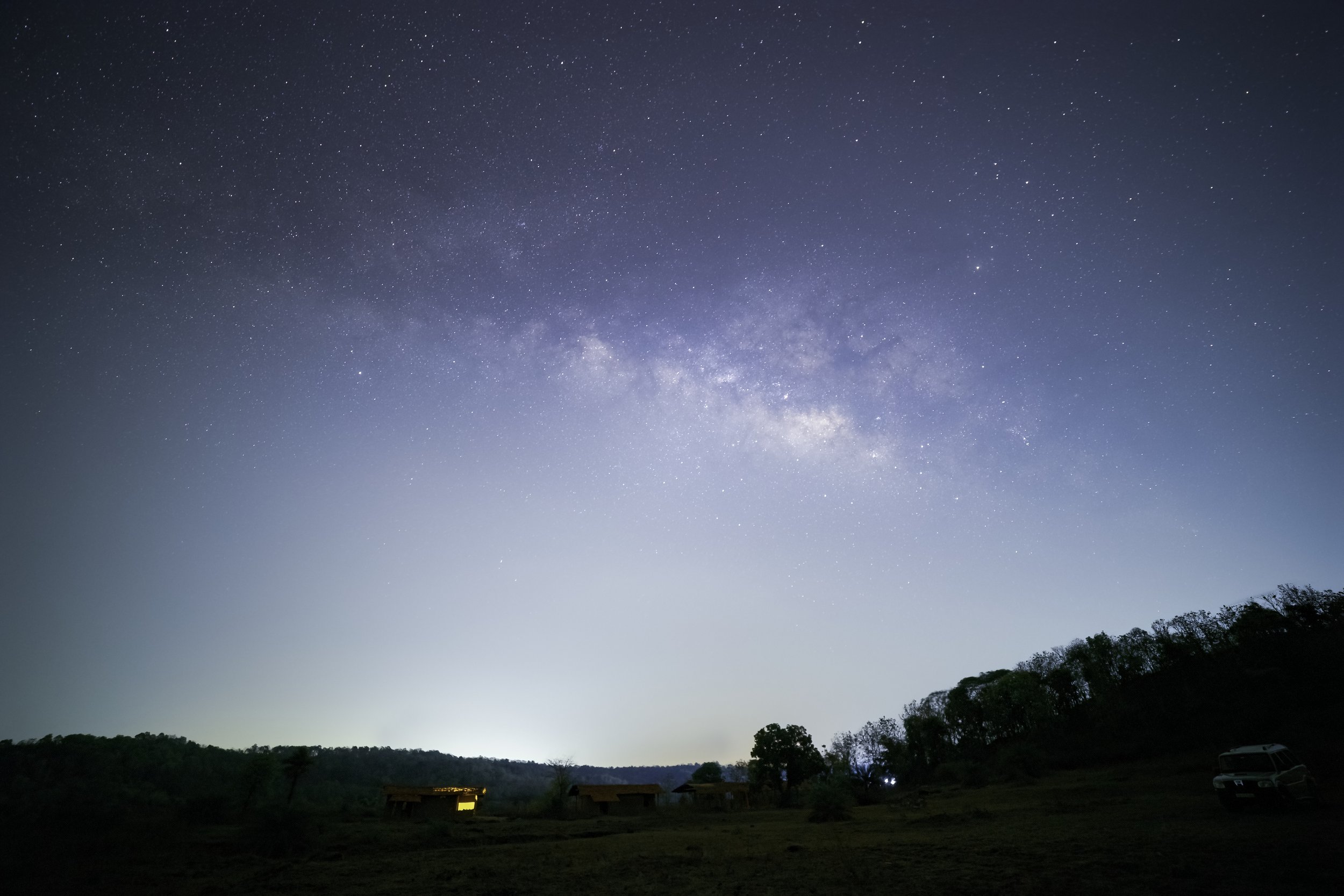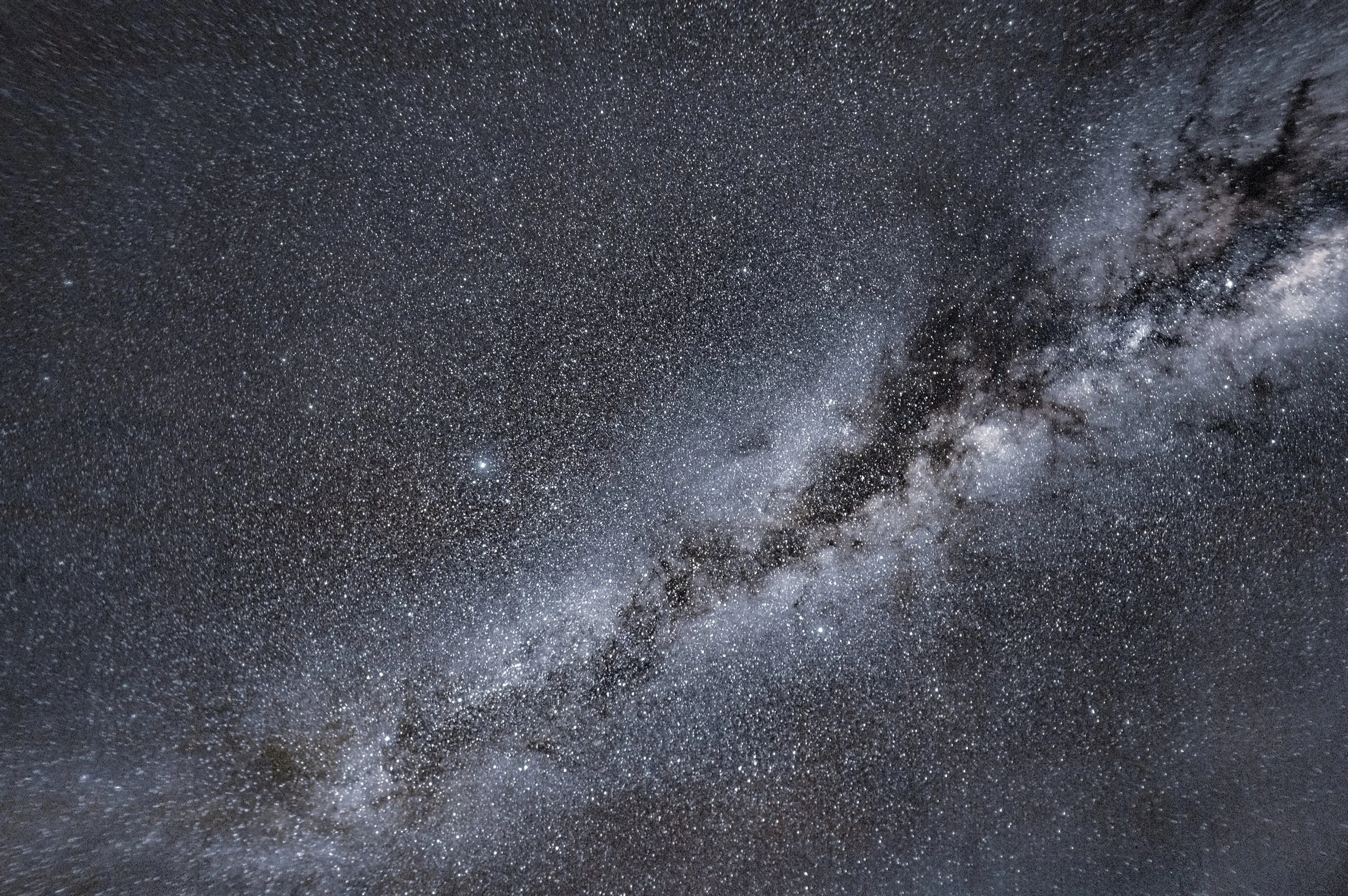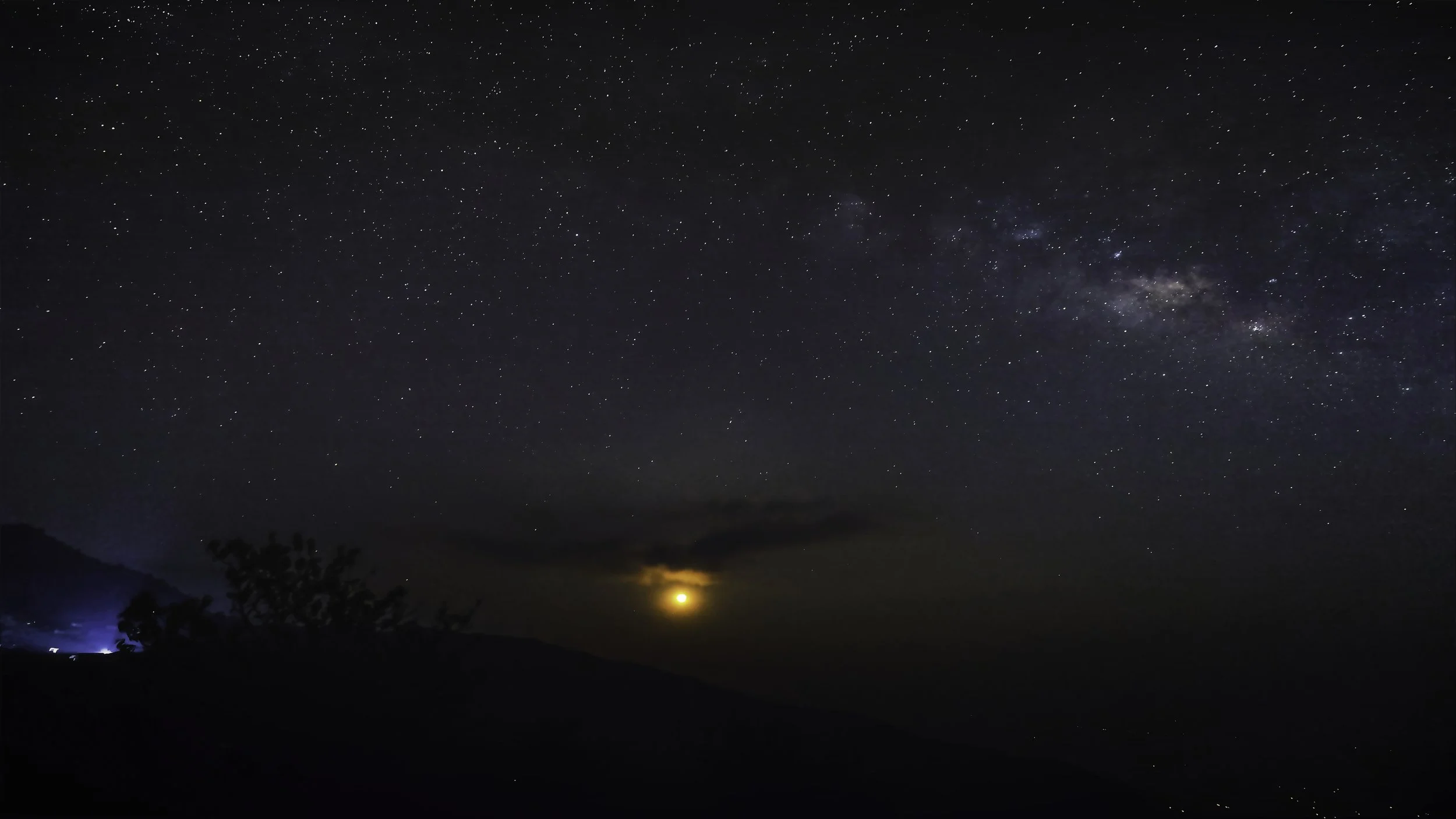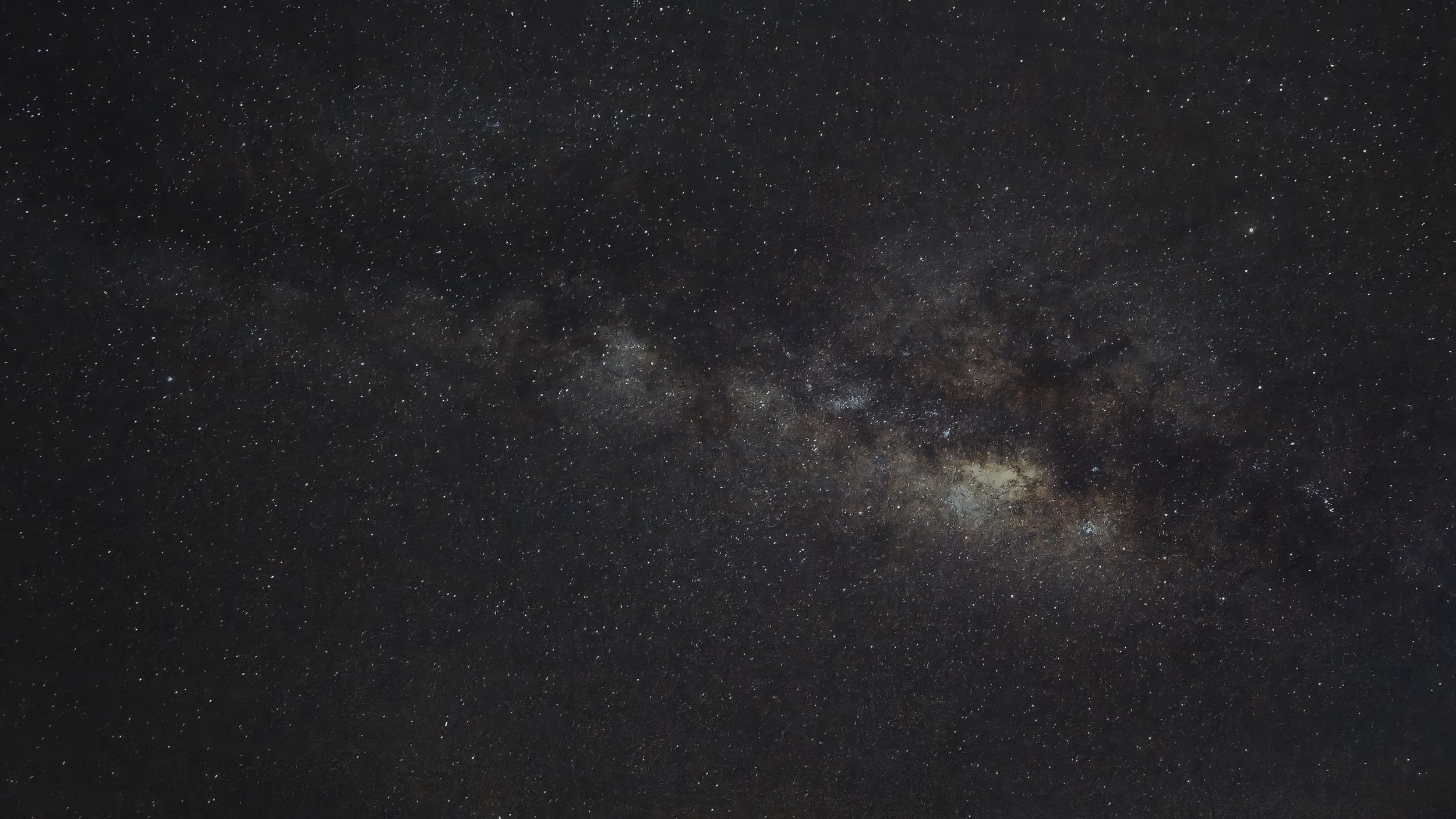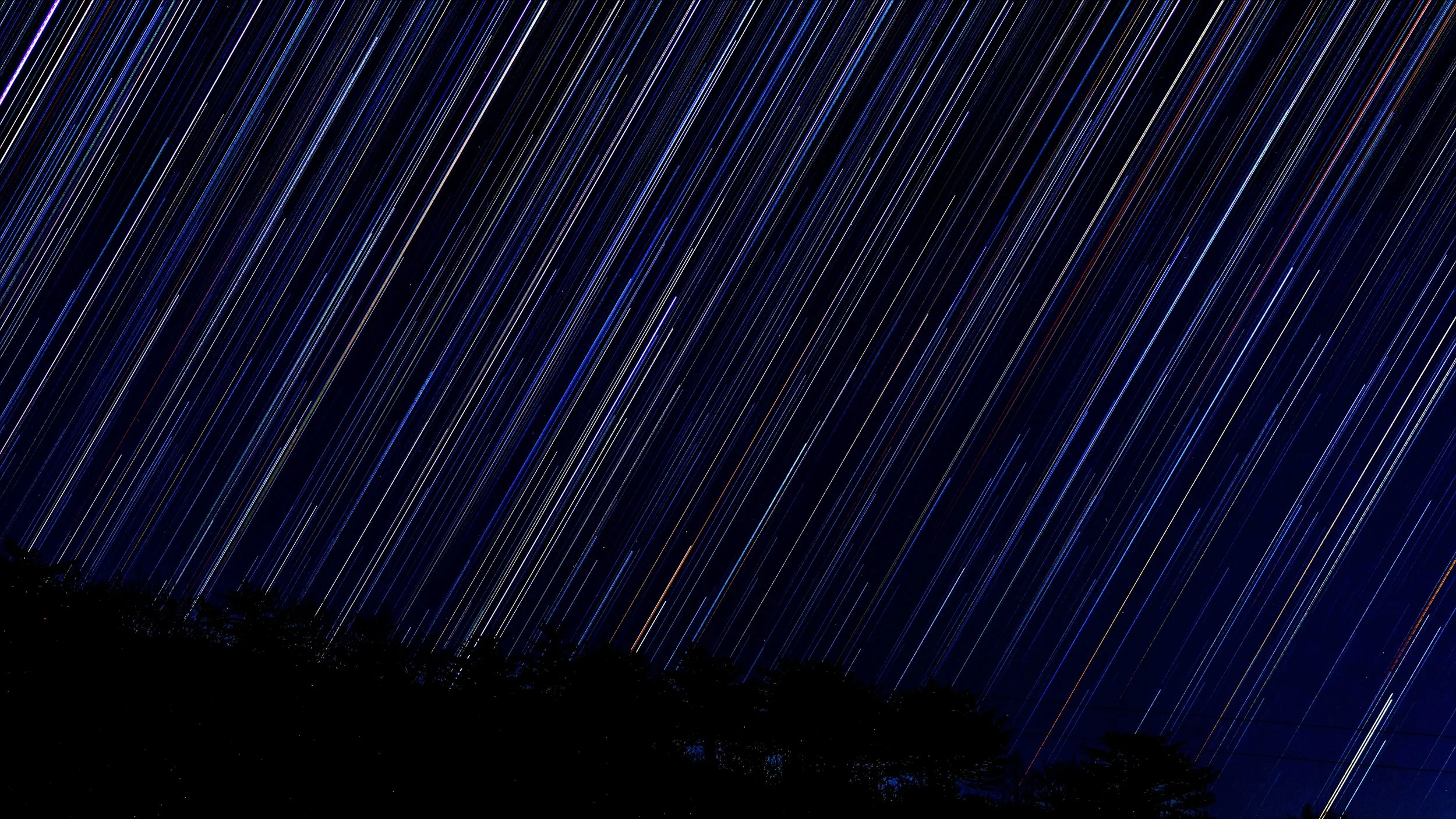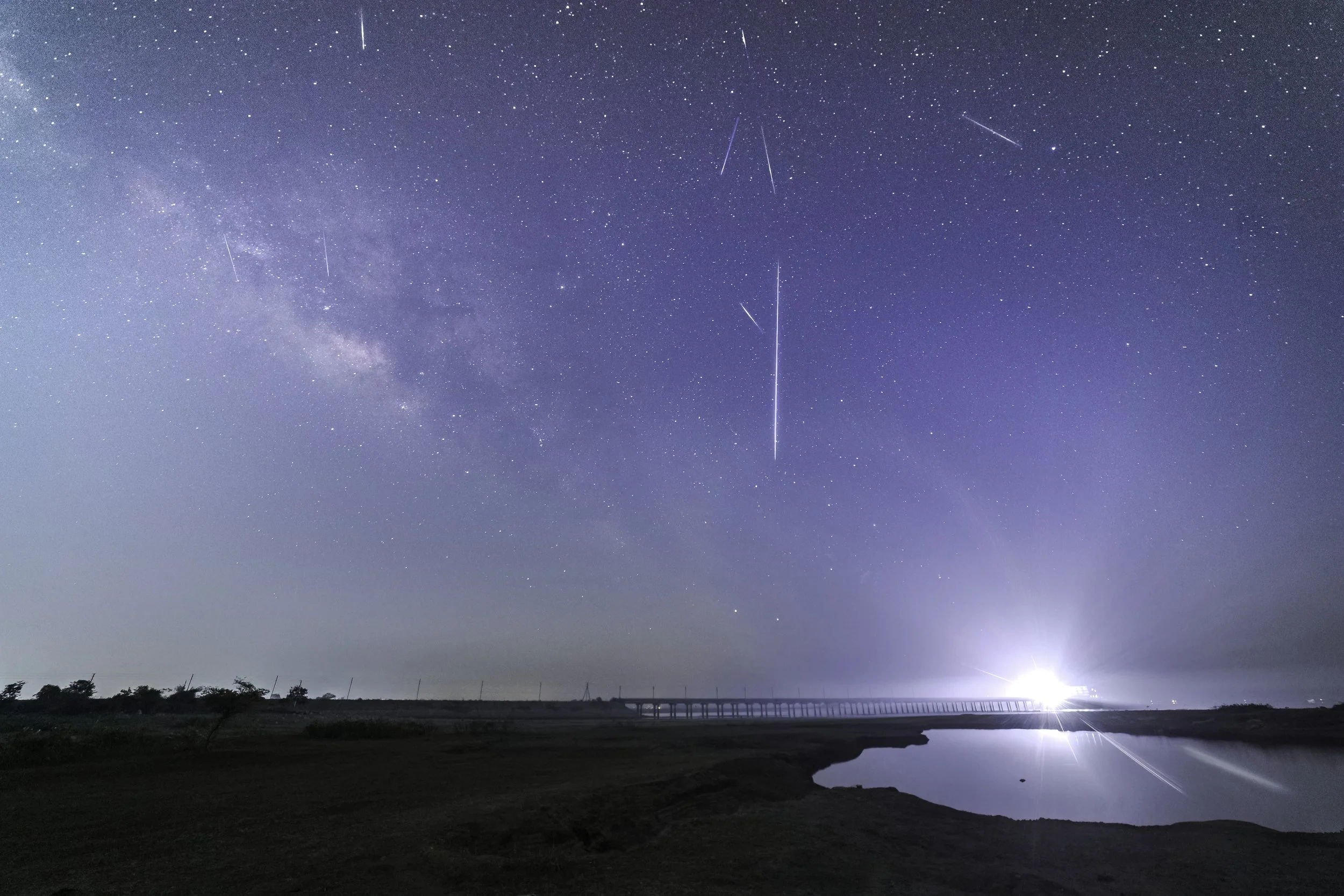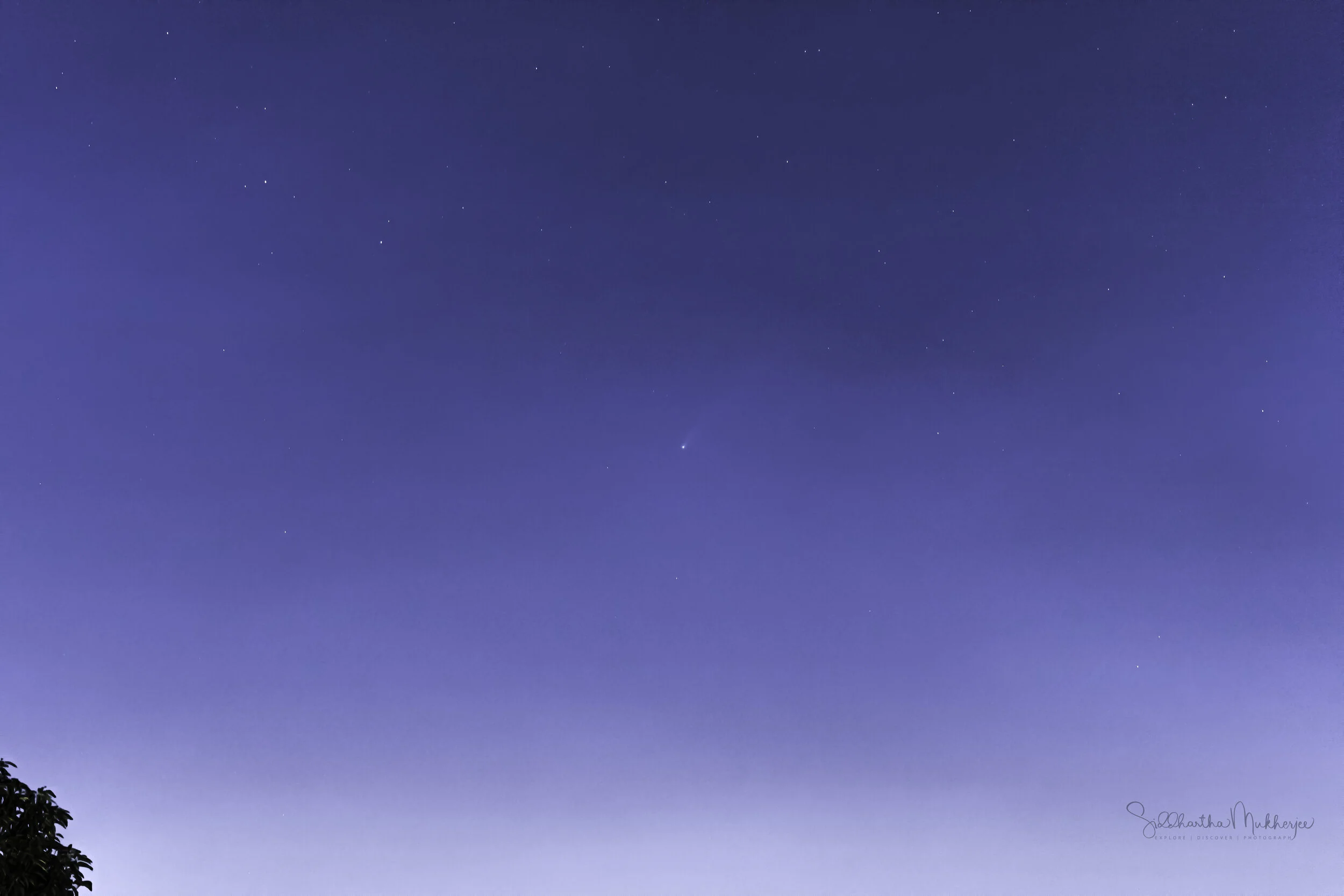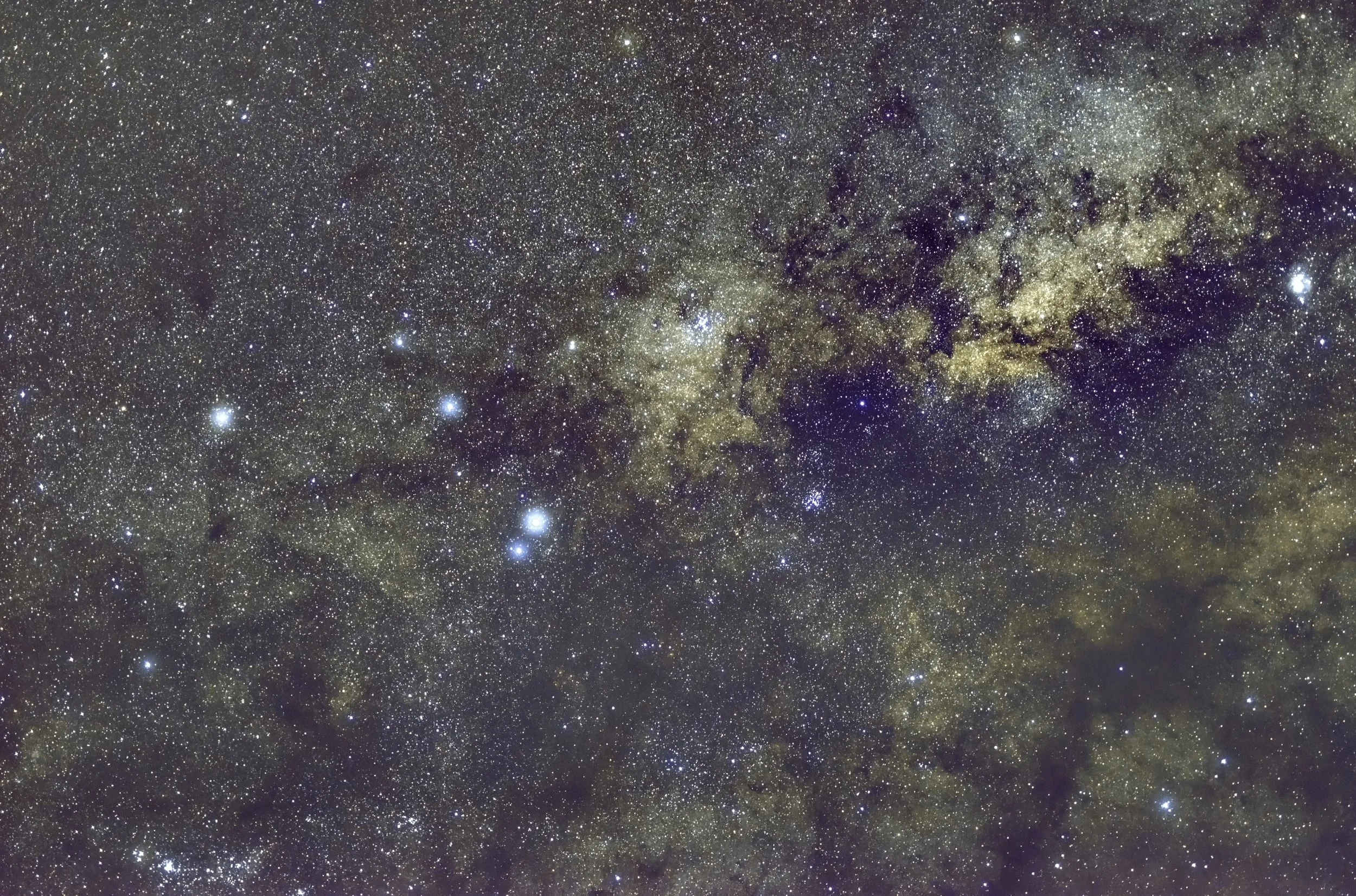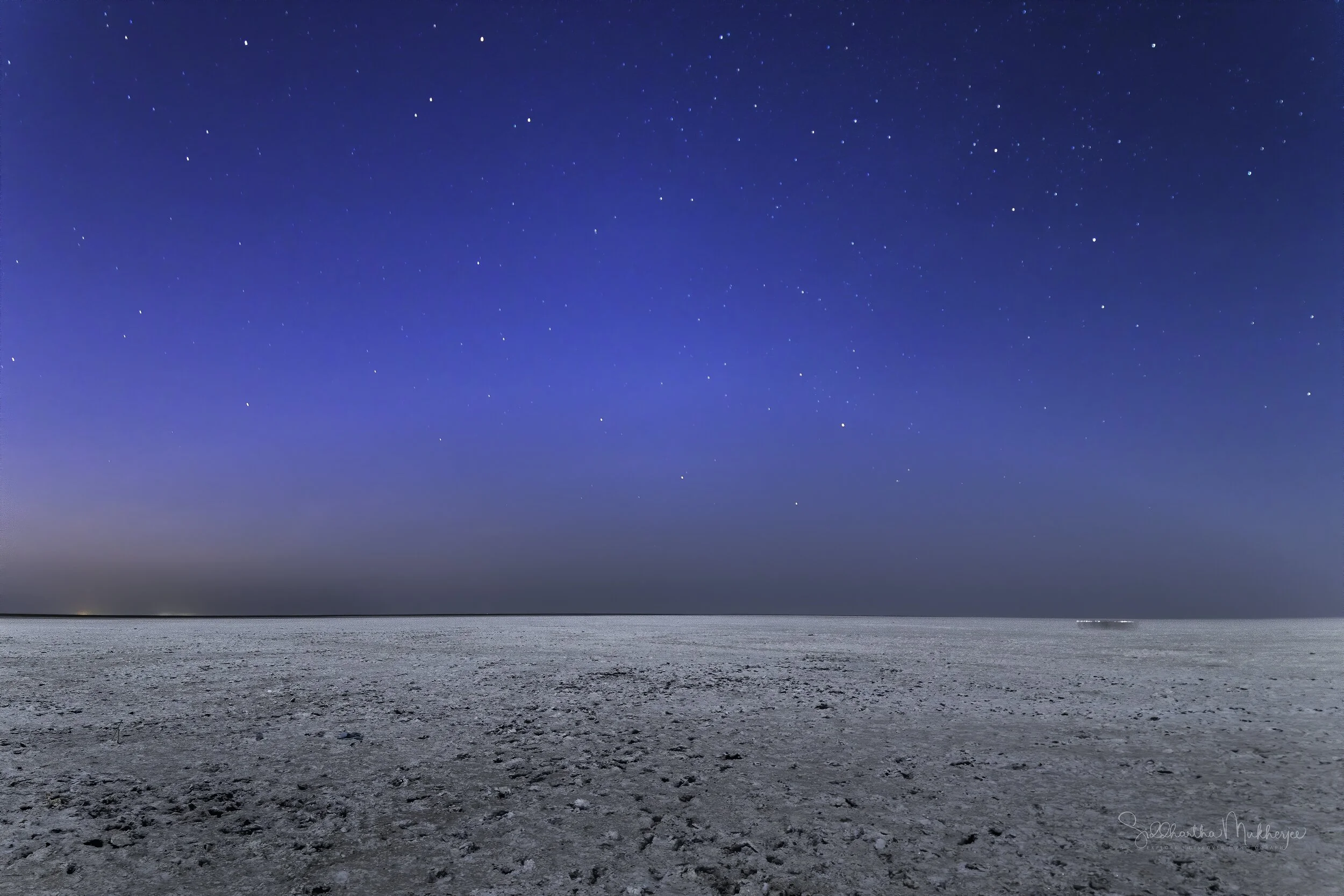
Socrates said "Man must rise above the Earth—to the top of the atmosphere and beyond—for only thus will he fully understand the world in which he lives."
And only when we look to the skies, rise above the atmosphere and beyond, do we see how small is man's body, how great his mind, since his intelligence can embrace the whole of this dazzling immensity, where his body is only an obscure point, and enjoy its silent harmony.
Blood Moon Eclipse - 7th September, 2025
On the night of September 7, 2025, observers across Asia, Australia, Africa, and Europe were treated to a rare and captivating celestial event: a total lunar eclipse, commonly known as a "Blood Moon". For approximately 82 minutes, the Moon took on a striking crimson hue as it passed through Earth's darkest shadow, captivating billions with its deep, dramatic red glow. The video and photos you see in this blog are what I could see from my home in Hyderabad - a Bortle 8-9 Sky.
The Video features the entire duration of the eclipse from 2000hrs to 0200hrs.
Exif: Canon 1Dx Mark ii | EF 600mm f/4L IS III USM | f/8 | 1/2 second | ISO 5000 | Manually focused
While historically viewed as an omen in some cultures, the September 2025 Blood Moon was, in reality, a beautiful display of celestial mechanics. It served as a powerful reminder of the intricate and predictable movements of our solar system. For millions, it was a moment to step outside and appreciate the awe-inspiring beauty of the cosmos, connecting them to the vastness of the universe under a single, breathtaking spectacle in the night sky.
Exif: Canon 1Dx Mark ii | EF 600mm f/4L IS III USM + Extender EF 2X III | f/8 | 1/2 second | ISO 2000 | Manually focused
Dark Skies of Gundala - 1st May, 2025
There are few views as awe-inspiring as seeing the Milky Way from a dark site. If someone unfamiliar with it sees a picture of the milky way without a terrestrial reference point, they might assume it was taken with a telescope. But the scale of the milky way is huge!
Once again in collaboration with HyTiCos I was at the Gond village of Gundala in north Telangana. The light pollution here is a Bortle 2 and allows for some beautiful views of the night sky.
Facing East-South East
Exif: Canon 1Dx Mark ii | Samyang (Rokinon) 14mm f/2.8 IF ED UMC | f/2.8 | 19 seconds | ISO 6400 | Manually focused with a Bahtinov Mask & WB set to Manual at 3550k.
Stacked Image composed of 25 Light frames and 25 Dark Frames for Noise elimination. The cottage in the foreground is lit from within with a tiny Lume Cube Air wearing a Warm Diffuser
Looking Straight Up
Exif: Canon 1Dx Mark ii | Samyang (Rokinon) 14mm f/2.8 IF ED UMC | f/2.8 | 19 seconds | ISO 3200 | Manually focused with a Bahtinov Mask & WB set to Manual at 3550k.
Stacked Image composed of 35 Light frames and 25 Dark Frames for Noise elimination. Background extracted & stacked in Siril and processed in Photoshop for additional detail.
The final result looks stretched on the outer edges given the extreme view of the angled 14mm perspective. I was trying to get the Milky Way to stretch diagonally across the frame. In both images the star Vega is clearly visible but the Siril stack clearly illustrates the dust lanes and star clusters and the huge number of stars - far more than what is visible in the Starry Sky Stack.
The Milky Way Rises over Jaubari, Ilam, Nepal - 26 March, 2025
Milky Way timelapses are a timeless way to capture the natural beauty of our galaxy. Milky Way photographs, either stacked or single, can only capture a single moment in time. Whereas a timelapse can provide a real sense of how large and beautiful the band looks as it crosses the night sky in video format. Discover what gear you need, what settings to use for Milky Way time-lapse videos, and tips for how to create a time-lapse.
Exif: Canon 1Dx Mark ii | EF16-35mm f4L IS USM @ 16mm | f/4 | 19 seconds | ISO 800 | Manually focused with a Bahtinov Mask & WB set to Manual at 3800k.
I took this handheld after I completed the timelapse. A stack of 3 light frames and 25 dark frames stacked in Starry Sky Stacker and post processed in Siril, Photoshop & LightRoom. I had to use multiple programs to eliminate the gradient caused by the Moon Light from the bottom left of the frame and the minor light spill caused on the right of the frame from a neighbouring LED light.
Multicoloured Star Trails, Singalila Ridge, Nepal - 23-24 March, 2025
Photographing Multicoloured Star Trails on the Singalila Ridge. Late in March I had explored some dark sky sites at Nirmal, in collaboration with HyTiCos, but those were from Light Polluted areas. The Singalila Ridge in contrast is a Bortle 1 Sky which allows for some spectacular multi coloured star trails. Read the blog to know how and watch the entire timelapse of Circumpolar Trails at 50mm and Star Lines/ Paths at 100mm
The Milky Way & Meteors over Nirmal - 26 February, 2025
In the last week of February, in collaboration with HyTiCos, I had the opportunity to explore some areas in Telangana which could be leveraged as dark skies for star gazing and astro photography. This is a location in the district of Nirmal which has spectacular naked eye visibility of some of the major constellations and star clusters as you can see in this timelapse.
At 18 minutes past midnight we also saw and photographed a brilliant meteor which lit up the sky. In total 9 separate meteors were captured throughout the night which I have composited into a single image with the Milky Way. Read more in the Blog.
Exif: Canon 1Dx Mark ii | Samyang (Rokinon) 14mm f/2.8 IF ED UMC | f/2.8 | 19 seconds | ISO 3200 | Manually focused with a Bahtinov Mask & WB set to Manual at 4600k.
Timelapse Start: 19:14:17 | Timelapse End: 06:47:14 | Total Duration of shoot: ~ 11 hours 33 minutes
9 separate meteors captured throughout the night composited into a single image with the Milky Way.
In search of the Perseids - 12 August, 2023
The Perseid meteor shower, which peaks in mid-August, is probably the best meteor shower of the year with swift & bright meteors frequently leaving long "wakes" of light and color behind them as they streak through the Earth's atmosphere. The Perseids are one of the most plentiful showers with about 50 to 100 meteors seen per hour. They occur with warm summer nighttime weather allowing sky watchers to comfortably view them.
The Perseids are known for their fireballs which are basically larger explosions of light and color that can persist longer than an average meteor streak. This is due to the fact that fireballs originate from larger particles of cometary material & these fireballs are also brighter, with apparent magnitudes greater than -3. These meteors come from leftover comet particles and bits from broken asteroids. When comets come around the Sun, they leave a dusty trail behind them and every year the Earth passes through these debris trails, which allows the bits to collide with our atmosphere and disintegrate to create fiery and colourful streaks in the sky.
The pieces of space debris that interact with our atmosphere to create the Perseids originate from Comet 109P/Swift-Tuttle. Discovered in 1862 by Lewis Swift and Horace Tuttle this is a large comet: its nucleus is 26 kilometers across which is almost twice the size of the object hypothesised to have led to the demise of the dinosaurs. Swift-Tuttle takes 133 years to orbit the Sun once and it was Giovanni Schiaparelli who realised in 1865 that this comet was the source of the Perseids.
Comet Swift-Tuttle last visited the inner solar system in 1992.
The following Milky Way composite is a stack of 23 photos to eliminate noise taken while waiting for the Perseids near my home city of Hyderabad. Pointing south as the core was setting, this sequence of photos is from the Canon 1Dx Mark ii wearing the Samyang (Rokinon) 14mm f/2.8 IF ED UMC at f2.8, ISO 2500 and exposed for 19 seconds at an altitude of 2,037.73 ft above MSL. The sky here is a Bortle 4 which is basically a brighter rural ambience. Under these skies the zodiacal light is still visible, but does not extend halfway to the zenith at dusk or dawn and there are light pollution domes visible in several directions as you can see here. The clouds are illuminated in the directions of the light sources, dark overhead and surroundings are clearly visible, even at a distance. The Milky Way well above the horizon is still impressive, but lacks detail. The portion of the Milky Way seen here is the section containing the zodiac constellations of Sagittarius and Scorpius observed just above the tree.
The devastating impact of light pollution:
A recent study showed that about a third of the world’s population has never seen the Milky Way with their naked eye. But just a little bit over a hundred years ago everybody could see the Milky Way with their naked from the comfort of their garden or roof top. Today almost 70-80% of our population across the globe now lives in an area where they cannot see the Milky Way and there is a funny story about this around the earthquake in Los Angeles in 1994 which caused a power outage. The emergency services that morning were inundated with calls about a weird cloud in the sky. People thought aliens were coming!
That weird cloud turned out to be the Milky Way. They’d never seen it before and didn’t know what was going on and people were terrified.
Light Pollution Map of Hyderabad and its vicinity
Light Pollution Map of South India illustrating just how few dark skies remain.
Sunspots - 1 May, 2022
Our sun is the star at the center of the Solar System, a nearly perfect ball of hot plasma heated to incandescence by nuclear fusion reactions in its core. The energy generated is radiated mainly as Visible Light, Ultraviolet Light and Infrared Radiation. It is our most important source of energy to sustain life on Earth. With a diameter of about 1.39 million kms (109 times that of the Earth) and a mass of 330,000 times the mass of the Earth, it accounts for about 99.86% of the total mass of the Solar System. Roughly 1/3 of the Sun’s mass consists of Hydrogen (~73%); the rest is mostly Helium (~25%), with much smaller quantities of heavier elements, including Oxygen, Carbon, Neon & Iron.
The Sun is a strange and dynamic place, and far from consistently active, with 11-year activity cycles that are linked with its magnetic field. These cycles have a marked peak and trough known as solar maximum and solar minimum, which solar scientists calculate based on sunspot numbers. Solar Cycle 25 is the current cycle, the 25th since 1755, when extensive recording of solar sunspot activity began. The cycle began in December 2019 with a smoothed minimum sunspot number of 1.8 and it is expected to continue until about 2030.
The Sun’s magnetic field controls its activity and the sunspots are temporary regions with strong magnetic fields, and solar flares and coronal mass ejections are produced by magnetic lines snapping and reconnecting, often at these sunspot sites.
The earliest record of sunspots is found in the Chinese I Ching, completed before 800 BC. The earliest record of a deliberate sunspot observation also comes from China, and dates to 364 BC. I am sure Indian history will also have some ancient treatises on the sun & its activity. The fist clear mention of a sunspot in Western literature is circa 300BC, by the ancient Greek scholar Theophrastus, a student of Plato & Aristotle and successor to the latter.
The first drawings of sunspots were made by the English monk John of Worcester in December 1128.
Sunspots were first observed telescopically in late 1610 by the English astronomer Thomas Harriot & Frisian astronomers Johannes and David Fabricius, who published a description in June 1611.
Man therefore, has been trying to observe, record & predict the behaviour of the sun for a very long time. But the sun is strange and dynamic and does not follow the rules of man who predicted the current cycle of solar activity would be mild. But the gap between the prediction and what's actually happening is pretty significant – and it's getting wider. Sunspot counts, used as a measure for solar activity, are way higher than the predicted values calculated by the NOAA, NASA, and the International Space Environmental Service. In fact, sunspot counts have been consistently higher than predicted levels since September 2020. This could mean that, in contrast to predictions, the Sun is in the swing of an unusually strong activity cycle.
Solar minimum, when the Sun's magnetic field is at its weakest, and characterised by minimal sunspot activity, takes place when the Sun's magnetic poles switch places. The most recent solar minimum took place in December 2019. We're currently in Solar Cycle 25, headed for solar maximum, slated for July 2025, the period at which sunspot activity peaks.
The following images taken around 0730 hours illustrate the sun just after it rose on 1st May 2022. Three regions are clearly visible and a fourth can be seen as a vague discolouration just below the third region in the image below going from the bottom to the top of the sun as seen from this location:
Region 3001 - in the lower half of the disc of the sun;
Region 2999 - almost at the middle and right of the disc of the sun;
Region 2995 - seen almost along the top edge of the disc of the sun;
Region 2997 - seen as a vague discolouration just below and to the left of Region 2995.
Find out more about these regions here.
First look with the Astronomik Hα 12nm
This is my first photo with the Astronomik Hα 12nm filter. Given that I am looking up at Bortle Class 9 skies it is practically impossible to see many stars even when the skies are clear. Only the brightest stars are visible if the conditions permit. So to observe from such heavily light polluted sites, imaging with Narrowband-Emission line filters is the best way to take great images, as all kinds of light pollution can be blocked with these.
This Hydrogen α filter blocks all unwanted light from artificial light-pollution, natural airglow and moonlight. Especially light from High- and Low-Pressure Sodium and mercury lights and all lines of natural airglow are 100% blocked. The filter increases the contrast between the sky-background and objects glowing at the Hα line at 656nm and allows for deep and contrasty images even with very heavy light pollution or with the full moon high up in the sky! This photo I took last night was with the rare Halloween Blue Moon - 99% moon visible per my Moon App. The stars visible are those that have the Hydrogen α emission. H-alpha (Hα) is a specific deep-red visible spectral line in the Balmer series with a wavelength of 656.28 nm in air; it occurs when a hydrogen electron falls from its third to second lowest energy level.
exif: 7D Mark ii; EF 70-200mm f/2.8L IS III USM at 135mm; ISO 1000; WB 4750K; 16*2 minute 26 second exposures stacked using the Starry Sky Stacker; Sky-Watcher Star Adventurer Pro & the Astronomik Hα 12nm narrowband filter. Color corrected in Lightroom and processed in Photoshop.
Sunspots have two main structures: a central umbra and a surrounding penumbra. The umbra is the darkest region of a sunspot and is where the magnetic field is strongest and approximately vertical, or normal, to the Sun's surface, or photosphere. The umbra may be surrounded completely or only partially by a brighter region known as the penumbra. The penumbra is composed of radially elongated structures known as penumbral filaments and has a more inclined magnetic field than the umbra. Within sunspot groups, multiple umbrae may be surrounded by a single, continuous penumbra.
The temperature of the umbra is roughly 3,000–4,500 K (2,700–4,200 °C), in contrast to the penumbra at about 5,780 K (5,500 °C) leaving sunspots clearly visible as dark spots. This is because the luminance of a heated black body (closely approximated by the photosphere) at these temperatures varies greatly with temperature. Isolated from the surrounding photosphere, a single sunspot would shine brighter than the full moon, with a crimson-orange color.
The Wilson effect implies that sunspots are depressions on the Sun's surface. The appearance of an individual sunspot may last anywhere from a few days to a few months, though groups of sunspots and their associated active regions tend to last weeks or months. Sunspots expand and contract as they move across the surface of the Sun, with diameters ranging from 16 km (10 mi) to 160,000 km (100,000 mi).
A zoom in of the first frame to highlight the 4 visible sunspot regions.
Exif: Canon 7DMii | TAMRON SP 150-600mm F/5-6.3 Di VC USD G2 A022 | f/6.3 | 1/100 | ISO 100
Two filters were used to extract the detail and increase contrast:
Thousand Oaks Optical Threaded Solar SolarLite Filter 95-T
Astronomik H-Alpha 12 nm
Manually focussed on the spots with manual metering & auto WB
Sunspot Regions 3001 & 2999 - 1st May 2022
Sunspot Regions 2999, 2995 & 2997 - 1st May 2022
A solar cycle following a longer cycle, they noticed, was likely to be on the weaker side. But a cycle following a shorter cycle was likely to be stronger. Solar Cycle 23 was long, which is consistent with the weakness of Solar Cycle 24. But Solar Cycle 24 was also short, coming in at just under 10 years.
This, predicted in 2020, meant that Solar Cycle 25 was likely to be stronger – perhaps among the strongest on record. And the climbing sunspot numbers would suggest they may have been onto something.
"Scientists have struggled to predict both the length and the strength of sunspot cycles because we lack a fundamental understanding of the mechanism that drives the cycle," McIntosh said at the time.
"If our forecast proves correct, we will have evidence that our framework for understanding the Sun's internal magnetic machine is on the right path."
In turn, this means we might be in for some pretty spectacular solar storms, following eruptions of solar flares and coronal mass ejections on the Sun. When the solar particles launched into interplanetary space collide with Earth's magnetic field and atmosphere, they can cause communications blackouts, power grid fluctuations and spectacular auroras. Aurora chasers are already having an absolute field day.
We probably won't have confirmation until after solar maximum, but we're looking forward to learning some fascinating new things about our fabulous home star. And gosh it's fun watching the solar cycle play out.
#wildartworks, #7DMkII, #AstronomikHAlpha, #Astrophotography, #Canon, #Tamron150600G2, BreakthroughPhotographyX4UV, #ProMediaGear, #Skygazers, #UrbanAstrophotography, #Sunspots, #DarkMoon, #ThousandOaksOpticalSolarLiteFilter, #solarcycle,
Sunspots photographed from the Yenkathala/ Ramnathgudpalle Grasslands on 21st Jan 2023 using the 600mm lens at sunrise. No filters were used.
The Great Conjunction of 2020 - Jupiter & Saturn - 21 December, 2020
The great conjunction of Jupiter & Saturn as seen on 21 December 2020 from a Bortle 8-9 sky. Jupiter and its moon Io along with Saturn and its rings are clearly visible and Jupiter’s bands can be vaguely made out. Effective focal length used 1344mm.
This great conjunction of Jupiter and Saturn will be the closest since 1623 and the closest observable since 1226!
Exif: Canon 7DMii | EF 600mm f/4 L IS iii + 1.4x iii | f/5.6 | single 1/8 second exposure | ISO 100 | 4750K
A second image taken with the same settings listed above but this time Europa is also visible below Jupiter.
As skywatchers we are in for an end-of-year treat. What has become known popularly as the “Christmas Star” is an especially vibrant planetary conjunction easily visible in the evening sky over the last two weeks as the bright planets Jupiter and Saturn come together, culminating on the night of December 21, 2020. Astronomers use the word conjunction to describe meetings of planets and other objects on our sky’s dome. They use the term great conjunction to describe meetings of the two biggest worlds in our solar system, Jupiter and Saturn.
Credits: NASA/JPL-Caltech
It has been nearly 400 years since the planets passed this close to each other in the sky, and nearly 800 years since the alignment of Saturn and Jupiter occurred at night, as it will for 2020, allowing nearly everyone around the world to witness this “great conjunction.”
The December 21, 2020, great conjunction of Jupiter and Saturn is already underway and highly conspicuous in the west after sunset each evening. On December 21, the pair will be only 0.1 degree apart. Some say the pair will look like an elongated star on that date. Will they? Or will they look like a double planet?
In 1610, Italian astronomer Galileo Galilei pointed his telescope to the night sky, discovering the four moons of Jupiter – Io, Europa, Ganymede, and Callisto. In that same year, Galileo also discovered a strange oval surrounding Saturn, which later observations determined to be its rings. These discoveries changed how people understood the far reaches of our solar system.
Thirteen years later, in 1623, the solar system’s two giant planets, Jupiter and Saturn, traveled together across the sky. Jupiter caught up to and passed Saturn, in an astronomical event known as a “Great Conjunction.”
“You can imagine the solar system to be a racetrack, with each of the planets as a runner in their own lane and the Earth toward the center of the stadium,” said Henry Throop, astronomer in the Planetary Science Division at NASA Headquarters in Washington. “From our vantage point, we’ll be able to be to see Jupiter on the inside lane, approaching Saturn all month and finally overtaking it on December 21.”
Jupiter-Saturn conjunctions happen every 20 years; the last one was in the year 2000. But these conjunctions aren’t all created equal. The 2020 great conjunction of Jupiter and Saturn will be the closest since 1623 and the closest observable since 1226! 2020’s extra-close Jupiter-Saturn conjunction won’t be matched again until the Jupiter-Saturn conjunction of March 15, 2080.
From our vantage point on Earth the huge gas giants will appear very close together, but they will remain hundreds of millions of miles apart in space. And while the conjunction is happening on the same day as the winter solstice, the timing is merely a coincidence, based on the orbits of the planets and the tilt of the Earth.
Jupiter is brighter than any star. Saturn isn’t as bright as Jupiter, but it is as bright as the brightest stars and shines with a distinctly golden color. Saturn is just to the east of Jupiter on the sky’s dome. The two are noticeable for their brightness and nearness to each other.
While you’re looking at them, you might notice that – unlike the twinkling stars – Jupiter and Saturn both shine steadily.
“Conjunctions like this could happen on any day of the year, depending on where the planets are in their orbits,” said Throop. “The date of the conjunction is determined by the positions of Jupiter, Saturn, and the Earth in their paths around the Sun, while the date of the solstice is determined by the tilt of Earth’s axis. The solstice is the longest night of the year, so this rare coincidence will give people a great chance to go outside and see the solar system.”
Exif: Canon 7DMii | EF 600mm f/4 L IS iii | f/4 | 50fps | ISO 800 | 4750K
#wildartworks, #Astrophotography, #Looktotheskies, #December, #Skygazers, #UrbanAstrophotography, #greatconjunction2020, #jupitersaturnconjunction, #December2020, #December17
The video below is a sequence of three timelapses as the planets - Jupiter & Saturn - set in the southwest on December 20.
First look with the Astronomik Hα 12nm
This is my first photo with the Astronomik Hα 12nm filter. Given that I am looking up at Bortle Class 9 skies it is practically impossible to see many stars even when the skies are clear. Only the brightest stars are visible if the conditions permit. So to observe from such heavily light polluted sites, imaging with Narrowband-Emission line filters is the best way to take great images, as all kinds of light pollution can be blocked with these.
This Hydrogen α filter blocks all unwanted light from artificial light-pollution, natural airglow and moonlight. Especially light from High- and Low-Pressure Sodium and mercury lights and all lines of natural airglow are 100% blocked. The filter increases the contrast between the sky-background and objects glowing at the Hα line at 656nm and allows for deep and contrasty images even with very heavy light pollution or with the full moon high up in the sky! This photo I took last night was with the rare Halloween Blue Moon - 99% moon visible per my Moon App. The stars visible are those that have the Hydrogen α emission. H-alpha (Hα) is a specific deep-red visible spectral line in the Balmer series with a wavelength of 656.28 nm in air; it occurs when a hydrogen electron falls from its third to second lowest energy level.
exif: 7D Mark ii; EF 70-200mm f/2.8L IS III USM at 135mm; ISO 1000; WB 4750K; 16*2 minute 26 second exposures stacked using the Starry Sky Stacker; Sky-Watcher Star Adventurer Pro & the Astronomik Hα 12nm narrowband filter. Color corrected in Lightroom and processed in Photoshop.
Star Trails
These spirals of bright stars trap people's eyes, in the same way a black hole would engulf the Millennium Falcon itself. Sorry Han Solo, this is how it is!
Such is the magnetic power of Star Trails.
Why?
Because we are seeing something remarkable, something that's happening out there, in the universe, but invisible to the naked eye:
"The movement of static stars tracing time, in the blackness of space.”
This, my friend, is incredibly hypnotic!
This North circumpolar star trail image was made waiting and watching the Geminid Meteor Shower on the night of 14th and 15th December 2020 from under Bortle Class 8-9 skies.
There were some spectacular meteors but only one faint one through this framing. The solitary meteor is to the bottom left of the image going from top to bottom. There are also the trails from three planes going through which should not be confused with the meteor :)
Exif: Canon 7DMii | EF 24mm f/1.4 ii | f/2.8 | 25s (each exposure) | ISO 100 | 4750K
564 Light frames & 47 Dark frames stacked with StarStax.
#wildartworks, #Astrophotography, #Looktotheskies, #December, #Skygazers, #UrbanAstrophotography, #geminids, #geminidmeteorshower, #AsteroidDebris, #3200Phaethon, #geminidmeteors, #startrailphotography, #startrails, #circumpolarstartrails, #NiSiNaturalNight
When Moon & Mars met - 28, 29 & 30 October, 2020
These last few nights – October 28, 29 and 30, 2020 – I watched for the bright waxing gibbous moon to sweep by the red planet Mars. Earlier this month, Earth came closest to Mars for this two-year period, and, in turn, Mars has been shining brilliantly in Earth’s sky, brighter even, than Jupiter. The Moon and Mars will share the same right ascension, with the Moon passing 2°58′ to the south of Mars. The pair was visible in the evening sky, becoming accessible around 18:15 IST above the eastern horizon. They will then reach their highest point in the sky around 23:00 IST and they will continue to be observable until around 04:30 IST. The moon can help find it in the next few nights. Full moon was on October 31. It’ll be the second full moon of this month, which many will call a Blue Moon.
For the second time during October and two evenings before the rare Halloween Full Moon, the moon and Mars appear together during early evening hours. I began by looking about an hour or so after sunset when the pair was about one-third of the way up in the sky in the east-southeast. At that time, Mars was nearly 30° up in the east-southeast, 4.8° to the upper right of the moon.
Mars supplanted the king planet Jupiter as the fourth brightest celestial body to light up the heavens (after the sun, moon and the planet Venus, respectively). In November 2020, however, Jupiter will reclaim its accustomed spot in the heavenly hierarchy. Earth, in its faster and smaller orbit around the sun, is now traveling away from Mars. Therefore, the red planet is slowly bur surely dimming in Earth’s sky. Nonetheless, Mars will continue to shine more brilliantly than a 1st-magnitude star for the remainder of 2020.
Because Mars has such an eccentric (oblong) orbit around the sun, Martian oppositions are far from equal. Especially close oppositions happen in late August/early September, and especially far oppositions in late February/early March. Source: earthsky.org
The photo above is in infrared with Mars as the little dot to the left of the Moon. And for once I was thankful of the few clouds around the moon catching the glow from the moon to create a halo of sorts.
exif: 7D Mark ii; EF 70-200mm f/2.8L IS III USM at 135mm; ISO 100; WB 4750K; 10 second exposure; Sky-Watcher Star Adventurer Pro & the Optolong L-eNhance dual narrowband filter.
Our planet Earth, in our faster and smaller orbit around the sun, laps Mars in periods of about 2 years and 2 months. Whenever Earth passes between Mars and the sun, Mars is said to be at opposition. It’s at opposition that Mars is opposite the sun in Earth’s sky. It’s at or around opposition that Earth comes closest to Mars for the year, and Mars, in turn, shines most brilliantly in Earth’s sky. Mars’ most recent opposition took place on October 13, 2020, and Mars’ next opposition will happen on December 28, 2022.
Yet, the next six oppositions of Mars will be farther away than this year’s, and Mars won’t showcase a brighter production until the opposition of September 15, 2035. We give the distances for Mars for the oppositions from 2020 to 2035, inclusive, in terms of the astronomical unit (AU). The astronomical unit is the sun-Earth distance of about 93 million miles or 150 million km.
Comet C/2020 F3 (NEOWISE) - 21 July, 2020
A faint Comet C/2020 F3 (NEOWISE), centered in the frame, photographed in the northwestern Bortle Class 8/9 skies over Hyderabad at 8pm on 21st July, 2020. This was the only 2 and a half hour window of clear skies I got from the time the comet was visible for the first time to the end of July. Numerous very early mornings and evenings spent waiting and watching for the clouds to clear to get this single photo. Read the Blog for the entire story of how I got this photo.
It is one of the brightest comets in the northern hemisphere since Comet Hale–Bopp in 1997 and after it leaves our Solar System this time it will not return for the next 6800 years.
7DMii + EF 70-200mm f2.8 Miii at 70mm, f/2.8, 6 second exposure, ISO 100
"This unexpected bright comet is uniting people right now just as the world needs something to bring it together. that’s the power that the night sky has." ~ Dr. John Barentine, International Dark Sky Association
Milky Way, Sungai Rengit - August 30, 2019
Timelapses of the Milky Way are a timeless way to capture the natural beauty of our galaxy as it moves across the sky. It helps provide a real sense of how large and beautiful the band looks as it crosses the night sky in video format. As we all know, the Milky Way is a barred spiral galaxy, it is a large object but is not as big as the closest galaxy to us (which, incidentally, is on a collision path with the Milky Way): the Andromeda Galaxy. We, as part of the Solar System, are at about half the distance from the center of the Milky Way galaxy to its outer edges. We are located in a smaller spiral arm – the Orion Arm – between two large arms. Read more.
7D Mark 2 + Sigma 50mm f/1.4 DG HSM ART, f/1.4, 3 second exposure, ISO 3200
This image is a stack of 37 light frames and 26 dark frames stacked and coloured in Siril with no star reduction used.
Partial Solar Eclipse - June 21, 2020
North Lunar Node - When the Moon moves from South to North in its orbit and crosses Sun's path – the incision point is called Rāhu or Dragon's Head Solar Eclipse.
Rahu is usually paired with Ketu which is also considered to be a shadow planet. The time of day considered to be under the influence of Rahu is called Rāhu kāla and is considered inauspicious.
Jupiter & starry skies over Bintan Island | #stargazing
Star trails looking towards Singapore from Bintan | #startrails
Moon at full perigee | #skygazers, #Moon
Sun through a Thousand Oaks Solar Filter | #Sun, #astrophotography
The Great Salt Desert of Kutch | The moonlight reflecting off the salt reduced the glow of the stars considerably.


